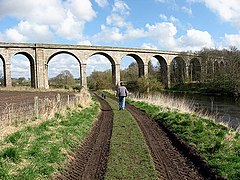Roxburgh Viaduct
| Roxburgh Viaduct | |
| Roxburghshire | |
|---|---|
 The Roxburgh Viaduct | |
| Location | |
| Type: | Raiway bridge |
| Crossing: | River Teviot |
| Location | |
| Grid reference: | NT70203041 |
| Location: | 55°33’59"N, 2°28’27"W |
| Structure | |
| Type: | Raiway bridge |
| History | |
| Built 1950 | |
| Information | |
Roxburgh Viaduct (also called the Teviot Viaduct) is a fine, curved railway viaduct across the River Teviot by Roxburgh Village in Roxburghshire. Though the railway for which it was built has long since closed, it remains an impressive monument to the engineering prowess of its age, and continues some part of its function by the footbridge it still carries over the river.
The viaduct was built across the River Teviot by the North British Railway in 1850, to a design by John Miller, who also designed the spectacular Ballochmyle Viaduct in Ayrshire.[1] It crosses the Teviot just upstream of the old ferry station and Wallace's Tower.
There are six main segemental arch spans to the viaduct, each of ashlar construction, flanked on each side by four shorter coursed-rubble, semi-circular arches.
The railway closed to regular passenger traffic (with the St Boswells - Sprouston Junction - Tweedmouth line) on 15 June 1964, and the track was later lifted. The approach bridge which linked the station to the viaduct has been demolished too. The station at Roxburgh is now a house.[2]

Footbridge
The Viaduct's four river piers are extended to one side to support a low-level footbridge, of a type which while supposedly once common, has very rarely survived.
The footbridge is 177 feet long, with three simply-supported spans of approximately 50 feet each, each made of a wrought-iron lenticular truss. The footbridge, though it looks tacked on, is thought to date from the same time as the viaduct.[1]
References
- ↑ 1.0 1.1 Roxburgh Viaduct – from 'The Happy Pontist'
- ↑ CANMORE (RCAHMS) record of Teviot Viaduct